Tel:+8618231198596

News
 CONTACT
CONTACT
 CONTACT
CONTACT
- Linkman:Linda Yao
- Tel: +8618231198596
- Email:linda.yao@dcpharma.cn
- Linkman:CHARLES.WANG
- Department:Overseas
- Tel: 0086 0311-85537378 0086 0311-85539701
News
Evaluating the stability and efficacy of Nisin under different food processing conditions.
TIME:2024-04-18
Impact of Temperature:
Temperature is a critical factor that can affect the stability and efficacy of nisin in food products. High temperatures encountered during processing, such as pasteurization or sterilization, can lead to denaturation and loss of activity. Conversely, low temperatures during storage can help maintain nisin stability. Therefore, it is essential to balance the need for microbial control with the preservation of nisin activity by optimizing processing temperatures and storage conditions.
Impact of pH:
The pH of the food matrix can significantly influence the stability and efficacy of nisin. Nisin exhibits optimal stability and activity at acidic pH levels, typical of many food products. However, in alkaline environments, such as those encountered in some bakery and dairy products, nisin stability may be compromised. Formulation adjustments or pH modification techniques may be necessary to ensure the effectiveness of nisin in these applications.
Impact of Processing Methods:
Different food processing methods can impact the stability and efficacy of nisin. For example, high-pressure processing (HPP) and pulsed electric field (PEF) treatments can cause physical and conformational changes in nisin molecules, affecting their antimicrobial activity. Conversely, mild processing methods, such as cold pressing or minimal heat treatment, may preserve nisin activity while achieving microbial control. Understanding the effects of various processing methods on nisin stability is essential for selecting the most suitable preservation techniques for specific food products.
Strategies for Enhancing Nisin Stability and Efficacy:
Several strategies can be employed to enhance the stability and efficacy of nisin in food products under different processing conditions:
Encapsulation: Encapsulation techniques can protect nisin molecules from degradation during processing and storage, improving their stability and release characteristics. Encapsulated nisin formulations can be tailored to specific food matrices, ensuring controlled release and prolonged antimicrobial activity.
Coating: Coating food surfaces with nisin-containing films or coatings can provide localized antimicrobial protection, reducing the risk of contamination during processing and storage. Coatings can be applied using edible polymers or lipid-based materials, offering additional barrier properties and enhancing nisin stability.
Synergistic Effects: Combining nisin with other natural preservatives or antimicrobial agents can create synergistic effects, enhancing overall efficacy against target microorganisms. Synergistic formulations can reduce the reliance on high concentrations of nisin while achieving equivalent or superior microbial control.
pH Adjustment: Modifying the pH of the food matrix to optimize nisin stability and activity can improve its effectiveness as a preservative. pH adjustment techniques, such as acidification or buffering, can create favorable conditions for nisin activity while minimizing degradation.
Conclusion:
The stability and efficacy of nisin as a food preservative are influenced by various processing conditions encountered during food production and storage. Understanding the impact of factors such as temperature, pH, and processing methods is essential for optimizing the use of nisin in different food applications. By employing strategies such as encapsulation, coating, synergistic formulations, and pH adjustment, food manufacturers can enhance the stability and efficacy of nisin while ensuring food safety and quality. Through careful formulation and processing optimization, nisin can serve as a reliable and effective natural preservative, contributing to the development of safer and more sustainable food products.
- Tel:+8618231198596
- Whatsapp:18231198596
- Chat With Skype







